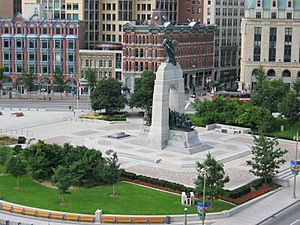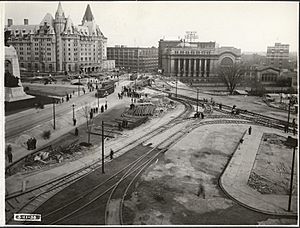Confederation Square facts for kids
Quick facts for kids Confederation SquarePlace de la Confédération (French) |
|
|---|---|

View of Confederation Square from the northeast
|
|
| Location | Ontario, Canada |
| Nearest city | Ottawa |
| Governing body | National Capital Commission |
| Designated | 1984 |
Confederation Square (in French, Place de la Confédération) is a very important public space in Ottawa, Ontario, Canada. It's like the second most important ceremonial spot in Canada's capital city, right after Parliament Hill.
This square is shaped roughly like a triangle. In its middle, you'll find Canada's amazing National War Memorial. There's also the Valiants Memorial nearby. The square is surrounded by Wellington Street to the north and parts of Elgin Street on its east and west sides.
Confederation Square was named a National Historic Site of Canada in 1984. This means it's a very special place in Canadian history. It's important because it's right in the middle of Ottawa. It's also a great example of a "City Beautiful" style square, which was a movement to make cities more beautiful and grand. Many famous buildings are around the square, like the Château Laurier, the Senate of Canada Building, and the National Arts Centre. Part of the square even goes over the Rideau Canal, which is also a National Historic Site and a World Heritage Site.
Contents
How Confederation Square Was Made
Long ago, there was a triangular area here called "Connaught Place." It was named after Governor General Connaught. Before 1910, the Plaza Bridge over the Rideau Canal was actually two separate bridges. These were replaced by one big bridge. This new bridge allowed trains to pass underneath from the new Union Station towards the Château Laurier. This work was finished by December 1912. The area was officially named "Connaught Place" on March 24, 1913.
Making Ottawa More Beautiful
Two Canadian prime ministers really wanted to make Ottawa more beautiful. They were Wilfrid Laurier, who was prime minister from 1896 to 1911, and William Lyon Mackenzie King, who first became prime minister in 1921. By 1927, a group called the Federal District Commission was created to help improve the city. Prime Minister King invited a French architect named Jacques Gréber to help design a new square. This new square would also include a special war memorial.
At that time, there were five important buildings in the area. The old post office was where the War Memorial stands today. The Russell House hotel was on the southeast side of Sparks and Elgin streets. The Russell Theatre was next to the hotel. The old City Hall was on the east side of Elgin. And Knox Presbyterian Church was at Elgin and Albert streets, where the National Arts Centre is now.
Prime Minister King had big plans to make Elgin Street wider, even back in 1927. He wanted to make Parliament Hill stand out more. The Russell House hotel burned down in a fire on April 14, 1928. The Russell Theatre also caught fire that day. The government bought the theatre to tear it down for the new plans. The Federal District Commission later bought the hotel's land too. The church was bought by the government on November 20, 1930. The City Hall also burned down on March 31, 1931.
Building the New Square
In 1937, Jacques Gréber visited Ottawa again. He didn't agree with Prime Minister King about where to put the War Memorial. Gréber was worried it would cause traffic problems.
The old Central Post Office in Ottawa had been built in 1876. This old post office was taken down in May and June of 1938 to make space for the new square. Knox Presbyterian Church was also torn down in June 1938. The Royal Bank of Canada building was also removed.
By October 1938, the War Memorial was put up. The Plaza Bridge was also made wider. Work began on building the new Central Post Office. Elgin Street was made wider in April 1939. The landscaping of Confederation Square continued while the post office was being finished. Around this time, the square was officially renamed Confederation Square because of the National War Memorial.
In May 1939, King George VI from the United Kingdom visited Ottawa. He officially showed the new War Memorial to everyone. It wasn't until June 1969 that the National Arts Centre finally opened.
See also
 In Spanish: Confederation Square para niños
In Spanish: Confederation Square para niños





